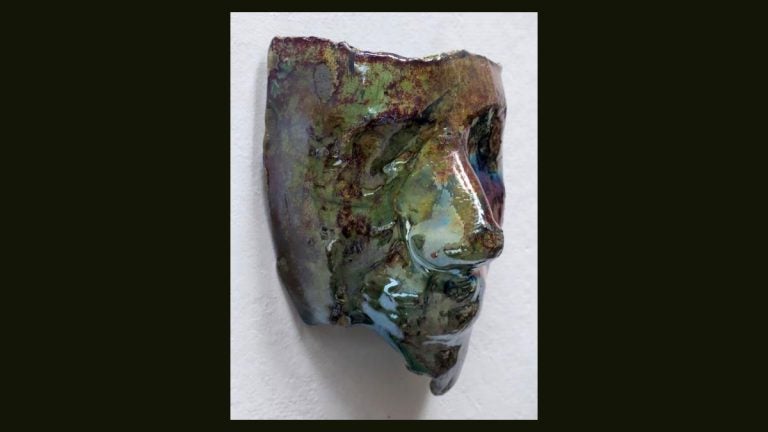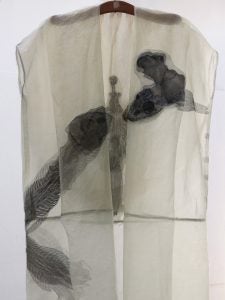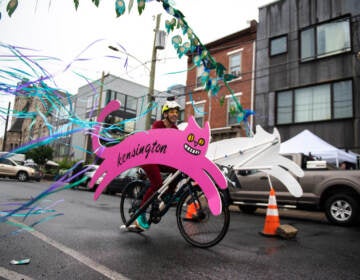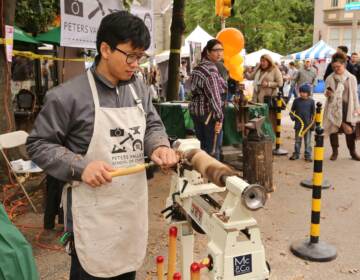Princeton art exhibit inspired by fears of a nuclear war
In commemoration of the human catastrophe in Japan, multimedia artist Marion Held has made ceramic masks, as well as evocative kimonos of organdy and paper.

Artist Marion Held created this mask after visiting Hiroshima, the site the U.S. dropped its first nuclear bomb in WWII. (Photo courtesy of Marion Held)
Never forget.
Those words are repeated after each incident, and yet there appears to be a whole lot of forgetting going on.
Nuclear devastation and forgetting was a theme of “Hiroshima Mon Amour,” the 1959 New Wave classic by Alain Resnais about the aftereffect of the atomic bomb as experienced by two lovers, but here we are at the cusp of a new year and two world leaders are taunting each other about the sizes of their nuclear arsenal.
North Korean Leader Kim Jong Un just stated that the “Nuclear Button is on his desk at all times.” Will someone from his depleted and food starved regime please inform him that I too have a Nuclear Button, but it is a much bigger & more powerful one than his, and my Button works!
— Donald J. Trump (@realDonaldTrump) January 3, 2018
After Trump was elected president of the U.S., “I became gravely concerned about the likelihood of deterioration in U.S.-international relations, especially regarding nuclear issues,” said Bernstein Gallery Co-Director Mary Hamill. The gallery, at Princeton University’s Woodrow Wilson School, is exhibiting “Shadows and Ashes: The Peril of Nuclear Weapons” through February 1, 2018.
“It was my good fortune at that time to meet Zia Mian and then to work afterward with him and Alexander Glaser and Tamara Patton to develop an art exhibition that would raise awareness about the peril of nuclear weapons.
Artwork by Marion Held, photographs by Gary Schoichet and drawings by child survivors that convey the horror of the devastation from the Hiroshima and Nagasaki bombings “are meant to be intellectual and emotional catalysts to awaken people to the dangers and to motivate them to make the world safer,” continues Hamill. “To prevent the catastrophe of a nuclear war, the powers of reason, imagination and human empathy are all critical.”
Video and wall displays by the Program on Science and Global Security provide up-to-date information on the risks from nuclear weapons and nuclear materials, the local and global long-term effects of the use of nuclear weapons, the U.S. nuclear weapons modernization plan and its expected costs, and the current effort to eliminate these weapons, including the new Treaty on the Prohibition of Nuclear Weapons agreed upon at the United Nations in 2017.
The Hiroshima Children’s Drawings were contributed by All Souls Church in Washington, D.C., where, in 1995, a box was discovered at the home of a parishioner containing 48 colorful drawings made by children. The artwork was in thanks for gifts received from the church 50 years earlier.
In 1945, the church’s pastor, shocked and enraged by news photos of the bombings, inspired his congregation to collect school supplies for the children of Honkawa Elementary School in Hiroshima, who had survived the bombing but lost 400 of their classmates and teachers. In December of 1947, school supplies and other gifts were delivered to Hiroshima.
In gratitude, those same children sent a collection of drawings to the All Souls parishioners depicting cherry blossoms, festivals, children playing and picking flowers, kites in the sky. The drawings in brilliant color conveyed the children’s memories of better times and their hopes and dreams for the future. They depict scenes of beauty and joy—self-portraits, a cityscape, festival flags and kites flying against a bright blue sky, children on a playground, cherry blossoms in bloom, city traffic on a bridge, a girl in a beautiful kimono.
Certainly, for children, forgetting is a healthy coping mechanism. There are no pictures of sadness, no trauma, no fear. None of the pictures reflect the horror that these children had endured less than two years earlier when a bomb like no other was dropped and detonated above their homes.
The pictures disappeared from view over the years until rediscovered in 1995. Conserved and stored in a vault, the pictures were brought to Hiroshima in 2010 and reunited with their makers, then in their 70s. The reunion of the artists and their artwork was documented in a film that reflects on the artists’ early lives amidst the rubble of their destroyed city and the hope their shared artwork created.
“I think I wished that these things existed, which is why I drew them,” said one of the artists who was 8 years old when she lost her entire family to the bomb. She was raised in two different foster homes, and her drawing of a schoolyard full of children playing on a merry-go-round and a slide is what she wished for.
In commemoration of the human catastrophe in Japan, multimedia artist Marion Held has made ceramic masks, as well as evocative kimonos of organdy and paper. The artist, who lives in Montclair, invokes memory and loss and compares her work to old bones, referencing the passage of time.
Held traveled to Hiroshima two years ago, and was so “infected” by visits to a peace park, seeing monuments and memorials, that she created the series of masks. “We saw objects pulled after the bombings and skeletons of buildings. I felt a kind of responsibility that my country did that. It’s very hard to deal with, and making art is my way of dealing.”

The garments she has made, transparent and ghostly, have been printed with drawings that suggest body organs. She started making garments about 11 years ago as a tribute to her mother, who liked to sew.
The masks “commemorate what I saw at Hiroshima, what’s left of a person who survived such a thing.”
Does the threat of nuclear war keep Held awake at night? “I think everyone has been listening and should be afraid. People should be thinking more about this, including our government. This show is very important.”
Photographer Gary Schoichet rounds out the exhibit with portraits and reflective comments of Hiroshima survivors, as well as documentary photographs of the 1982 Anti-Nuclear Rally in New York City. “The actual effects of it…were with these people for the rest of their lives,” Schoichet says. “Families were lost, and histories lost…so maybe if people start to feel for other people, something will happen.”
The Bernstein Gallery is located in Robertson Hall’s Bernstein Lobby, and is free and open to the public Monday-Friday, 9 a.m. to 5 p.m.
WHYY is your source for fact-based, in-depth journalism and information. As a nonprofit organization, we rely on financial support from readers like you. Please give today.





